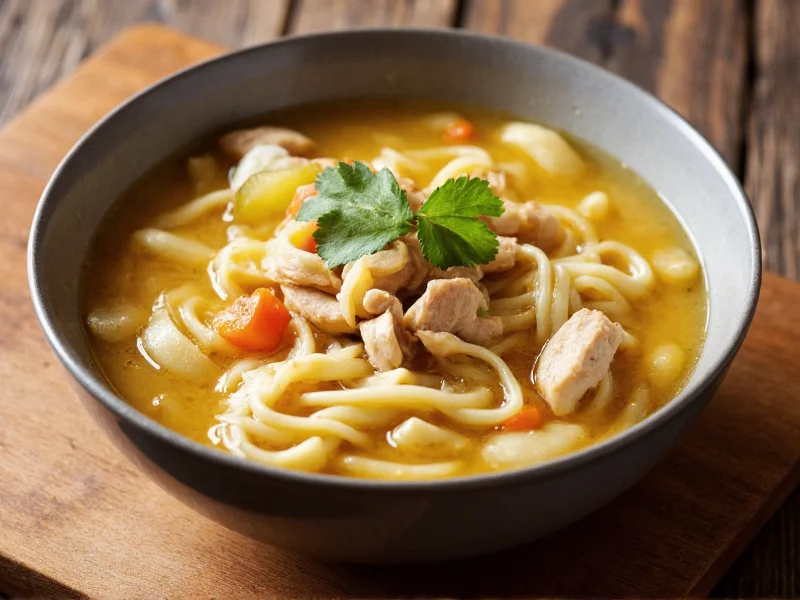Chicken and egg noodles soup represents one of Asia's most beloved comfort foods, with variations spanning multiple cultures while maintaining its core identity. This nourishing combination of tender poultry and delicate egg noodles in a clear broth has sustained generations across Chinese communities and beyond. The dish's simplicity belies its complex flavor profile, achieved through careful broth preparation and ingredient balancing.
The Cultural Significance of Chicken and Egg Noodles Soup
With roots in southern Chinese cuisine, chicken and egg noodles soup evolved as a practical solution for using available ingredients to create nourishing meals. Traditional Chinese medicine principles influenced its development, as the soup's warming properties help balance "yin" conditions like colds and fatigue. During Chinese New Year celebrations, families often prepare this soup to symbolize prosperity and family unity.
As Chinese immigrants traveled worldwide, they adapted the recipe using locally available ingredients while preserving essential elements. In Southeast Asia, versions incorporate coconut milk and lemongrass. North American adaptations sometimes include additional vegetables like carrots and celery while maintaining the fundamental chicken and egg noodles foundation.
Essential Ingredients Explained
The magic of authentic chicken and egg noodles soup lies in its carefully selected components. Each element contributes specific textures and flavors that create the complete experience:
| Ingredient | Function | Substitution Options |
|---|---|---|
| Chicken bones with meat | Creates rich broth base | Whole chicken parts, turkey bones |
| Egg noodles (fresh) | Provides signature texture | Dry egg noodles, rice noodles (changes character) |
| Ginger (sliced) | Adds warmth and depth | Galangal (different flavor profile) |
| Green onions | Finishing freshness | Chives, scallions |
| Garlic | Flavor foundation | Shallots (milder alternative) |
Step-by-Step Preparation Guide
Creating an exceptional homemade chicken and egg noodles soup requires attention to broth development and proper noodle handling. Follow these steps for restaurant-quality results:
- Broth preparation: Place 2 pounds chicken bones (with some meat attached) in a large pot with 8 cups cold water. Add 3 slices ginger and 2 smashed garlic cloves. Bring to a gentle simmer (not boil) and skim foam for 10 minutes.
- Simmering: Reduce heat to low and maintain a gentle simmer for 1-2 hours. Avoid vigorous boiling which clouds the broth. Add salt only during the last 30 minutes of cooking.
- Chicken cooking: After broth simmers for 45 minutes, add 1 pound boneless chicken thighs. Cook until tender (about 20 minutes), then remove and shred.
- Noodle preparation: Cook fresh egg noodles separately according to package directions (usually 2-3 minutes). Rinse under cold water to stop cooking and prevent sticking.
- Assembly: Strain broth into clean pot. Return to gentle heat. Add shredded chicken, cooked noodles, and sliced green onions. Heat through without boiling.
Perfecting Your Chicken and Egg Noodles Soup Recipe
Several techniques elevate basic chicken and egg noodles soup to exceptional status. Professional chefs emphasize these critical elements:
- Broth clarity: Start with cold water and maintain a gentle simmer throughout cooking. Rapid boiling emulsifies fat into the broth, creating cloudiness.
- Noodle texture: Never cook noodles directly in the soup broth. This releases starch that clouds the broth and creates uneven noodle texture. Cook separately and add just before serving.
- Flavor layering: Add ingredients in stages - aromatics first, then proteins, finishing with delicate elements like green onions added at the end.
- Seasoning timing: Salt only during the final 30 minutes of broth preparation. Early salting draws moisture from ingredients, weakening flavor development.
Regional Variations Worth Trying
Chefs across Asia have developed distinctive interpretations of traditional chicken and egg noodles soup. Exploring these variations expands your culinary repertoire:
- Cantonese style: Features clear, delicate broth with minimal seasoning beyond salt and white pepper. Often includes ginseng and dried longan for medicinal properties.
- Singaporean version: Incorporates curry leaves and coconut milk for a subtly spiced variation while maintaining the chicken and egg noodles foundation.
- Taiwanese adaptation: Adds preserved vegetables and a touch of vinegar for brightness, creating a more complex flavor profile.
- Western interpretation: Often includes additional vegetables like carrots and celery, with herbs like parsley and thyme reflecting European influences.
Serving and Storage Recommendations
Proper presentation enhances the enjoyment of chicken and egg noodles soup while appropriate storage maintains quality:
- Serving temperature: Serve piping hot (165°F/74°C minimum) in pre-warmed bowls to maintain temperature throughout the meal.
- Garnish options: Fresh cilantro, sliced red chili, or a drizzle of sesame oil add visual appeal and complementary flavors.
- Storage: Keep broth and noodles separate. Refrigerate broth for up to 4 days or freeze for 3 months. Store cooked noodles in water to prevent sticking.
- Reheating: Gently warm broth without boiling. Add noodles separately just before serving to maintain optimal texture.
Troubleshooting Common Issues
Even experienced cooks encounter challenges with chicken and egg noodles soup preparation. Address these frequent problems:
- Cloudy broth: Caused by rapid boiling or insufficient skimming. Next time, maintain gentler heat and skim foam more thoroughly during initial heating.
- Mushy noodles: Results from overcooking or leaving noodles in hot broth too long. Cook noodles separately and add just before serving.
- Bland flavor: Insufficient simmering time or improper seasoning. Extend simmering duration and season only during final cooking stages.
- Fatty broth: Inadequate fat removal during skimming. Chill broth after cooking, then remove solidified fat from surface before reheating.











 浙公网安备
33010002000092号
浙公网安备
33010002000092号 浙B2-20120091-4
浙B2-20120091-4